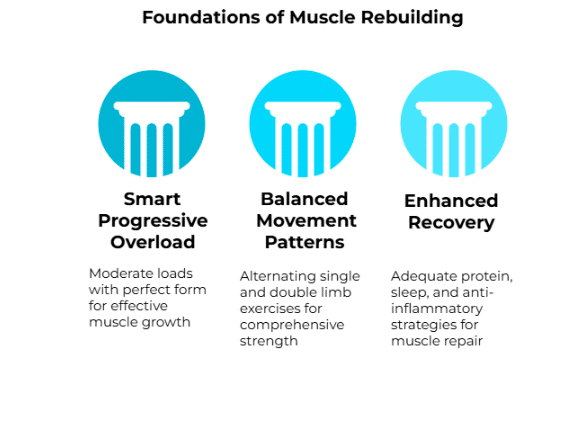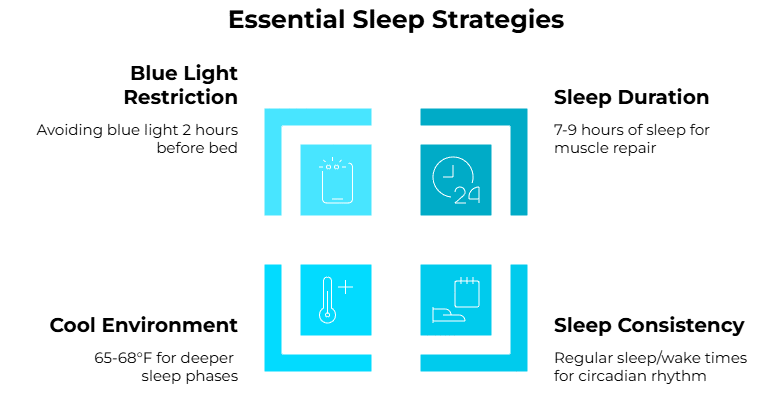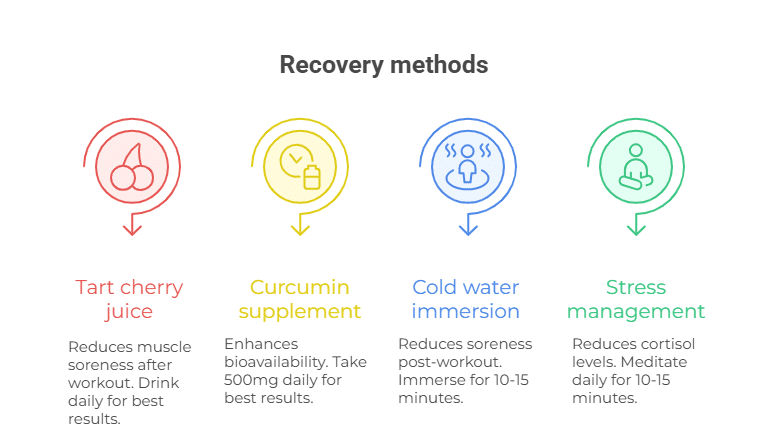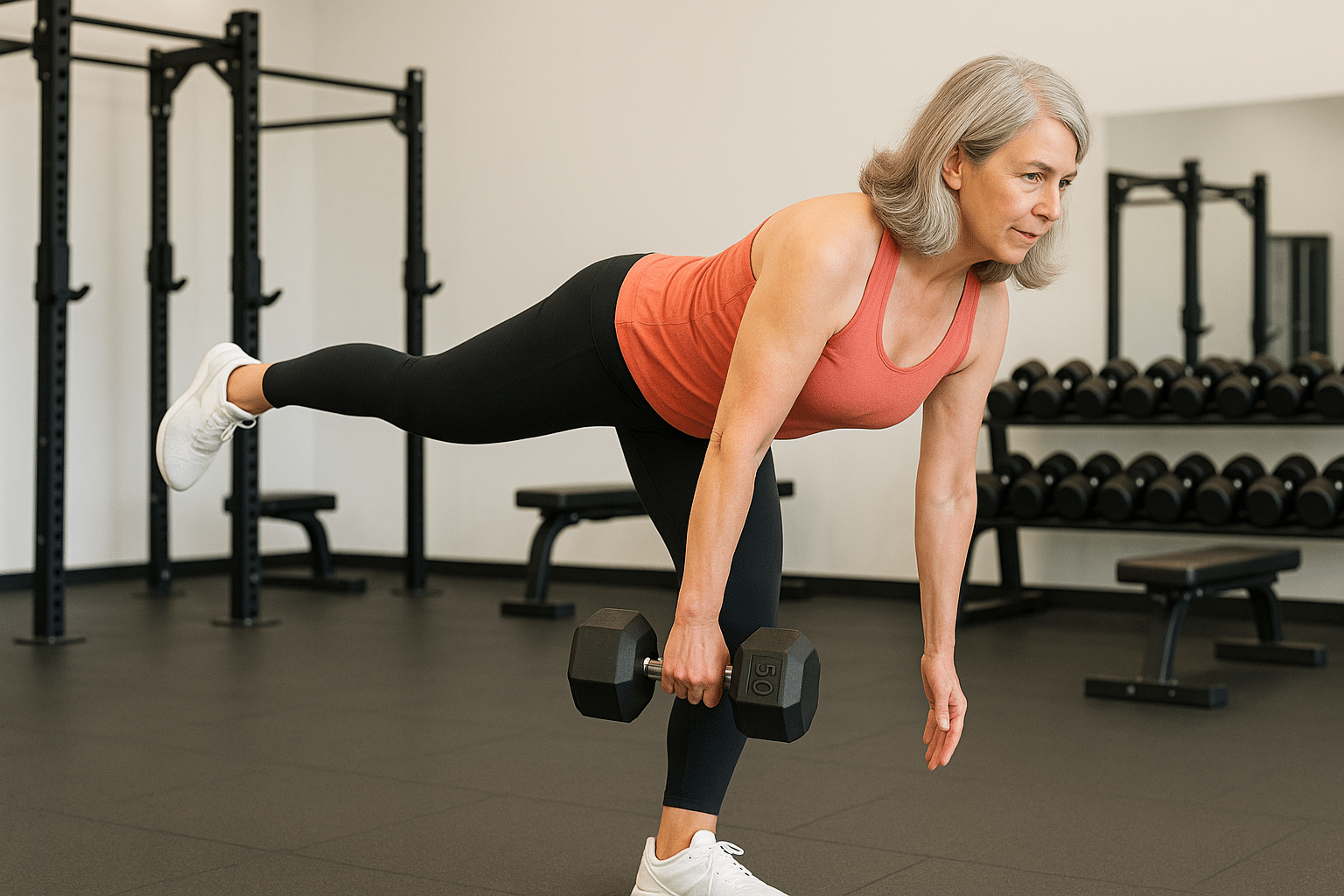Learn the proven strategies for successful muscle rebuilding after 50, backed by research and designed specifically for post-menopausal women.
Table of Contents
- Quick Start Guide
- The Science of Muscle Rebuilding After 50
- The 1-2 Cross Body Strength Formula™
- Workout Programs
- Nutrition for Muscle Rebuilding
- Recovery Strategies
- Progress Tracking
- Daily Wellness Check
- Common Mistakes
- FAQ
Quick Start Guide
Bottom Line: Muscle rebuilding after 50 requires a smarter approach than generic fitness advice. Here’s what works:
The 3 Pillars of Muscle Rebuilding After 50
- Smart Progressive Overload – Moderate loads (65-80% 1RM) with perfect form
- Balanced Movement Patterns – Alternating single-limb and double-limb exercises
- Enhanced Recovery – 40g protein per meal, 7-9 hours sleep, anti-inflammatory strategies
Your First 30 Days
- Week 1-2: Master bodyweight versions of all movements
- Week 3-4: Add light external load, focus on form
- Training frequency: 3x per week, 48-72 hours between sessions
- Key metric: Can you complete all reps with 2-3 in reserve?

The Science of Muscle Rebuilding After 50
Most advice on muscle rebuilding after 50 falls into two extremes: overly cautious programs that avoid meaningful load, or generic “hardcore” routines designed for younger lifters.
Neither approach optimizes muscle rebuilding after 50.
The key insight: your body still responds to strength training the same way it did decades ago, but muscle rebuilding after 50 requires adjustments for hormonal changes, recovery capacity, and joint health.
The Hormonal Reality of Muscle Rebuilding After 50
After menopause, declining estrogen directly impacts muscle rebuilding after 50 by affecting:
- Bone density
- Muscle protein synthesis rates
- Recovery capacity
Research shows women lose approximately 3-8% of their muscle mass per decade after age 30, with accelerated loss post-menopause. However, a 2019 study found that resistance training can partially offset this decline even during muscle rebuilding after 50.
Key Finding: Post-menopausal women experienced a 30% reduction in muscle protein synthesis rates, but resistance training improved muscle fiber recruitment and increased insulin-like growth factor-1 (IGF-1).
Progressive Overload for Muscle Rebuilding After 50
A 2020 meta-analysis in Sports Medicine revealed that muscle rebuilding after 50 responds optimally to:
- Moderate loads: 65-80% 1RM vs. maximum intensity
- Higher frequency: 3x per week vs. 1-2x per week
- Controlled tempo: 3-second lowering phase for superior strength gains
The 1-2 Cross Body Strength Formula™
This system is specifically designed for muscle rebuilding after 50. It alternates single-limb and double-limb lifts to create balanced strength while protecting joints during muscle rebuilding after 50.
Why This Approach Works for Muscle Rebuilding After 50
- Improved core stability – Essential as proprioception declines with age
- Reduced bilateral strength deficits – Common issue in muscle rebuilding after 50
- Enhanced functional movement – Translates to daily activities
- Lower joint stress – Crucial for sustainable muscle rebuilding after 50
The Formula Structure
Each workout for muscle rebuilding after 50 includes:
- Push movement (alternating 1-arm/2-arm)
- Quad-dominant leg exercise (alternating 1-leg/2-leg)
- Pull movement (alternating 1-arm/2-arm)
- Hip/hamstring-dominant exercise (alternating 1-leg/2-leg)
Workout Programs
Workout A: Foundation for Muscle Rebuilding After 50
| Exercise | Type | Progression | Modification |
|---|---|---|---|
| Single-arm dumbbell bench press | 1-Arm Push | Start with 70% of bilateral weight. Focus on preventing trunk rotation. | Use 30-45° incline to reduce shoulder stress |
| Goblet squat | 2-Leg Quad | Add 2.5-5 lb when completing sets with 2-3 reps in reserve | Squat to deepest pain-free range |
| Seated row | 2-Arm Pull | Neutral spine, 2-second pause at finish position | Alternate grip weekly for muscle fiber variation |
| Single-leg Romanian deadlift | 1-Leg Hip | Master 12 bodyweight reps before adding load | Use stable support for balance |
Sets/Reps for Muscle Rebuilding After 50: 3 sets of 8-12 reps, rest 90-120 seconds between sets
Workout B: Advanced Muscle Rebuilding After 50
| Exercise | Type | Progression | Modification |
|---|---|---|---|
| Overhead press | 2-Arm Push | Ensure full shoulder mobility before loading | Start seated if standing causes compensation |
| Split squat | 1-Leg Quad | Elevate rear foot 4-6 inches, avoid pushing off back foot | Reduce range if knee discomfort occurs |
| Single-arm row | 1-Arm Pull | Tempo: 2-second pull, 1-second hold, 3-second lower | Support non-working hand for balance |
| Barbell Romanian deadlift | 2-Leg Hip | Keep bar close to legs throughout movement | Use dumbbells if grip/back issues arise |
Frequency for Optimal Muscle Rebuilding After 50: Alternate Workout A and B, 3x per week with 48-72 hours rest between sessions
Nutrition for Muscle Rebuilding After 50
Nutrition becomes even more critical for muscle rebuilding after 50 due to decreased protein synthesis efficiency and higher leucine thresholds.
Protein Strategy for Muscle Rebuilding After 50
Target: 40g protein per meal, evenly distributed throughout the day
High-Leucine Foods for Muscle Rebuilding After 50:
- 6 oz chicken breast (2.8g leucine)
- 1 cup Greek yogurt (2.5g leucine)
- 1 scoop whey protein (2.7g leucine)
- 3 whole eggs (1.5g leucine)
Key Supplements for Muscle Rebuilding After 50
Vitamin D3: 2000-4000 IU daily
- Maintains muscle function during muscle rebuilding after 50
- Improves strength and reduces fall risk by 15-20%
- Take with fat-containing meal for absorption
Creatine Monohydrate: 3-5g daily
- Research shows 8-15% improvement in upper body strength
- Enhances cognitive function during training
- No loading phase needed for muscle rebuilding after 50
Omega-3 Fatty Acids: 2-3g EPA/DHA daily
- Reduces inflammation that impairs muscle rebuilding after 50
- Supports recovery between training sessions
Recovery Strategies
Recovery determines the success of muscle rebuilding after 50. Your adaptation happens during rest, not during training.
Sleep Optimization for Muscle Rebuilding After 50
Adults engaged in muscle rebuilding after 50 need:
- 7-9 hours per night for optimal muscle repair
- Consistent sleep/wake times to maintain circadian rhythm
- Cool environment (65-68°F) for deeper sleep phases
- Blue light restriction 2 hours before bed

Active Recovery for Muscle Rebuilding After 50
- Protein timing:
Every 4-5 hours to maintain elevated muscle protein synthesis - Hydration:
Half your body weight in ounces daily, plus 16-20 oz per training hour - Light movement: Walking, mobility work, or gentle cycling on rest days
Inflammation Management
Chronic low-grade inflammation (“inflammaging“) can impair muscle rebuilding after 50. Natural anti-inflammatory strategies:
- Tart cherry juice: 8-12 oz daily reduces muscle soreness by 25%
- Curcumin with black pepper: 500mg daily for enhanced bioavailability
- Cold water immersion: 10-15 minutes at 50-60°F post-workout
- Stress management: 10-15 minutes daily meditation reduces cortisol by 15-20%

Progress Tracking
The scale doesn’t measure muscle rebuilding after 50 success. Track these metrics instead:
Strength Metrics for Muscle Rebuilding After 50
- Heavier weights for same reps – Most objective progress measure
- More reps at same weight – Indicates improved muscular endurance
- Better form and range of motion – Video yourself monthly
- Increased stability during single-leg work – Shows improved balance/proprioception
Functional Improvements from Muscle Rebuilding After 50
- Carrying groceries without strain
- Climbing stairs with ease
- Getting up from floor without assistance
- Improved posture and reduced back pain
Advanced Tracking Methods
Heart Rate Variability (HRV): Use apps like HRV4Training to guide training intensity during muscle rebuilding after 50. Low HRV = focus on technique over intensity.
Sleep Quality: Track deep sleep percentage (aim for 15-20%) and sleep efficiency (85%+) using devices like Oura Ring or WHOOP.
Body Composition: DEXA scan or bioelectrical impedance quarterly to measure actual muscle gain during muscle rebuilding after 50.
Daily Wellness Check
Monitor your readiness for muscle rebuilding after 50 with this interactive tracker:
Daily Wellness Check for Muscle Rebuilding After 50
Rate each area 1-10. Scores below 6 suggest prioritizing recovery today.
Maintain your current training intensity. All wellness markers support muscle rebuilding activities.
Common Mistakes
Avoid these errors that sabotage muscle rebuilding after 50:
❌ Relying on cardio as the primary tool for body composition
Why it fails: Cardio burns calories during activity, but muscle rebuilding after 50 increases metabolic rate for up to 38 hours post-exercise through EPOC.
❌ Neglecting posterior chain training
The problem: Modern lifestyle creates anterior dominance. Successful muscle rebuilding after 50 requires 2-3 pulling exercises for every pushing exercise.
❌ Using the same weights for months
The solution: Progressive overload doesn’t require big jumps. Add 1.25 pounds per side or increase reps by 1-2 per set to maintain adaptation stimulus for muscle rebuilding after 50.
❌ Following programs designed for 20-somethings
The reality: Young adults can handle 4-6 training days per week. Optimal muscle rebuilding after 50 occurs with 3-4 quality sessions.
❌ Skipping mobility and movement prep
The fix: A 10-minute dynamic warm-up reduces injury risk by 50% and optimizes performance for muscle rebuilding after 50.
❌ Ignoring pain signals
The distinction: Muscle fatigue vs. joint pain. Muscle rebuilding after 50 should challenge muscles but never cause sharp joint pain. When in doubt, reduce load and focus on form.
❌ Comparing progress to younger versions of yourself
The mindset shift: Muscle rebuilding after 50 is about optimizing your current potential, not competing with your 30-year-old self. Focus on consistent improvement from your current baseline.
FAQ
How long does muscle rebuilding after 50 take to show results?
Strength gains: 2-4 weeks due to improved motor unit recruitment
Visible muscle changes: 6-8 weeks with consistent training and nutrition
Significant muscle rebuilding: 12-16 weeks of progressive training
Is muscle rebuilding after 50 safe with arthritis?
Yes! The Arthritis Foundation recommends resistance training as first-line treatment. Controlled loading during muscle rebuilding after 50 actually reduces arthritis symptoms by strengthening muscles around joints and improving synovial fluid circulation.
Start with: Isometric exercises (holding positions) before progressing to full range-of-motion movements.
Will muscle rebuilding after 50 make me “bulky”?
No. Women over 50 have significantly lower testosterone levels, making excessive muscle growth physiologically unlikely. The “bulky” appearance comes from muscle gain without fat loss, not from building too much muscle during muscle rebuilding after 50.
How much protein do I need for muscle rebuilding after 50?
Target: 40g protein per meal, evenly distributed
Daily total: 1.2-1.6g per kg body weight
Key insight: Leucine thresholds are higher during muscle rebuilding after 50, requiring 2.5-3g leucine per meal
Can I do muscle rebuilding after 50 with osteoporosis?
Yes, with proper guidance. Weight-bearing exercise is actually recommended for bone health. However, avoid spinal flexion under load and work with a qualified trainer experienced in muscle rebuilding after 50 with bone density concerns.
What if I haven’t exercised in years?
Start with bodyweight movements and focus on form mastery. Week 1-2 should be learning movement patterns. Week 3-4 begin adding light external resistance. The principles of muscle rebuilding after 50 work regardless of starting fitness level.
Take Action: Your Muscle Rebuilding After 50 Starts Now
Muscle rebuilding after 50 isn’t just possible – it’s essential for maintaining independence, bone health, and quality of life. The research clearly shows that resistance training provides more health benefits for women over 50 than any other single intervention.
Your Next Steps:
- Week 1: Master the bodyweight versions of Workout A and B movements
- Week 2: Continue bodyweight focus, add the daily wellness check routine
- Week 3: Begin adding light external load while maintaining perfect form
- Week 4: Establish your baseline weights and begin progressive overload
Ready to optimize your muscle rebuilding after 50? The strategies in this guide are based on the latest research and specifically designed for the unique challenges women face after menopause. Your strongest, most confident years can still be ahead of you.
Disclaimer: This information is for educational purposes and shouldn’t replace medical advice. Consult your healthcare provider before beginning any muscle rebuilding program after 50, especially if you have chronic health conditions or take medications.




